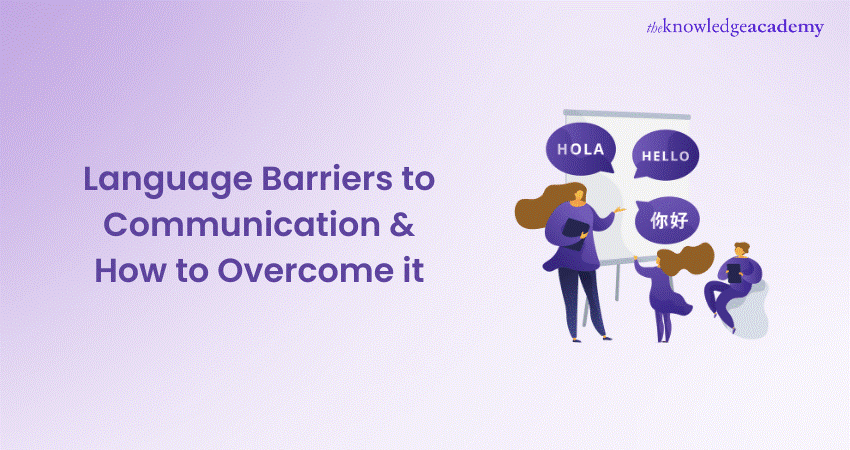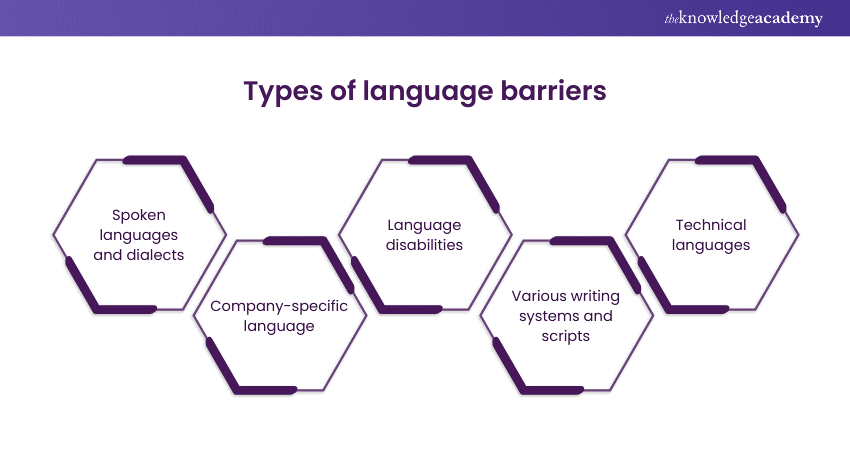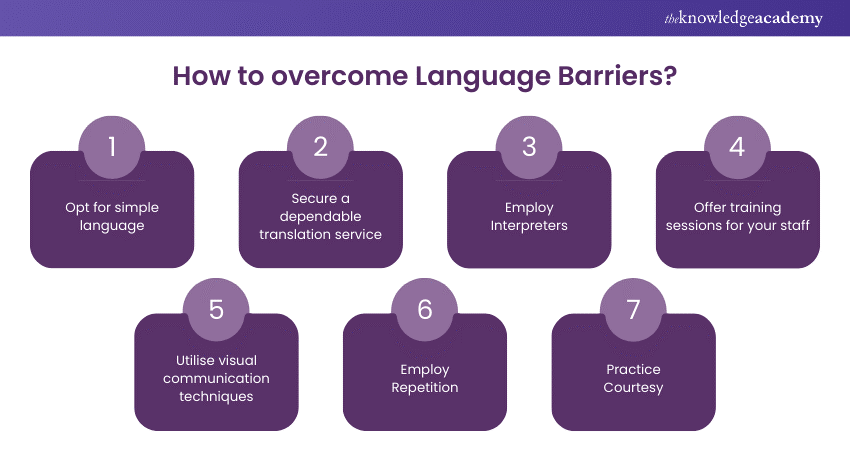We may not have the course you’re looking for. If you enquire or give us a call on +49 8000101090 and speak to our training experts, we may still be able to help with your training requirements.
Training Outcomes Within Your Budget!
We ensure quality, budget-alignment, and timely delivery by our expert instructors.

Picture a world where words are keys, but not everyone holds the right ones. This is the realm of Language Barriers to Communication—a silent challenge that can turn vibrant dialogues into mazes of misunderstanding. Yet, with creativity and empathy, we can forge keys that unlock any linguistic lock, uniting voices in harmony. This blog delves into Language Barriers to Communication and presents practical solutions to overcome these obstacles.
Table of Contents
1) What is a Language Barrier?
2) Types of Language Barrier
3) Impact of Language Barriers on business
4) Overcoming Language Barriers
5) Conclusion
What is a Language Barrier?
The Language Barrier is a sort of invisible wall that divides people not only by the way they speak but also by their different worlds. It transcends the simple incompatibility of languages; it is a void that can block the exchange of knowledge, feelings, and experiences. When we meet a person whose language we don’t understand, it feels like a part of our human experience that is unreachable.
This barrier isn’t just about different national languages; it can also be about dialects, accents, or even the specialised jargon used in various professions. Everyone has a unique language tailored to their life and experiences, and sometimes, these languages don’t align, creating gaps in understanding.
A Language Barrier is a human issue—it’s about connection or the lack thereof. It’s about the frustration of not being able to express your thoughts and feelings and the loneliness that comes when you realise that your words might never be fully understood by someone else. It’s about the effort we must put in to bridge these gaps, to reach out with more than words—to communicate with gestures, expressions, and empathy—to ensure that no voice goes unheard and no story goes untold.
Types of Language Barriers
Language Barriers represent a complex challenge in our increasingly interconnected world. These barriers can arise from various sources and affect how we communicate, understand, and interact. Let's delve deeper into each type of Language Barrier, exploring their nuances and their impact on our interactions.

1) Spoken languages and dialects
More than 7,000 spoken languages are known worldwide, and numerous dialects are within them. For example, Mandarin and Cantonese are both Chinese languages. However, their speakers may not understand each other because of major differences in pronunciation and vocabulary. In the same way, the English spoken in the United States is as different from that spoken in Scotland as in the accent, idioms and slogans. Such variations may result in misunderstanding and misinterpretation of speech during daily interactions, business engagements, and diplomatic relations.
2) Company-specific language
In business, companies create their internal vocabulary, which can blend acronyms, buzzwords, and technical phrases. For instance, a recruit at Amazon might struggle with any abbreviations such as ‘Weekly Business Review’ (WBR) and ‘Can’t Realise a Profit’ (CRaP). Such language without proper onboarding can alienate new employees and affect Communication effectively.
3) Language disabilities
Language disorders are a complex group of disabilities. Dyslexia impacts reading and writing functions, making it difficult for people to read and write. This can be a source of issues in educational and vocational settings where one is required to read. Aphasia, which may result from a stroke or injury in the brain, can prevent a person from being able to use and understand language, making it lonely and frustrating for that individual.
4) Various writing systems and scripts
The diversity of writing systems adds another layer of complexity. For example, a person fluent in spoken Japanese may find reading a text in Arabic challenging, as the scripts are entirely different. Even within a single language like Chinese, simplified and traditional characters can pose difficulties for readers accustomed to only one form.
5) Technical languages
Technical languages are full of specialised vocabulary that can be incomprehensible to outsiders. In the legal field, terms like ‘res judicata’ or ‘stare decisis’ are commonplace but may require explanation for those without legal training. In medicine, words like ‘hypertrophic cardiomyopathy’ describe specific conditions but can be jargon to non-medical professionals.
Overcoming Language Barriers: Various strategies can be employed to bridge these gaps. For spoken languages, translators and Interpreters play a vital role in facilitating Communication. In companies, clear and comprehensive training can help demystify internal language.
For those with language disabilities, tailored educational programs and assistive technologies can provide support. Exposure and education can help individuals become familiar with different writing systems and scripts. Lastly, professionals can use layman’s terms to explain technical concepts to those outside their field.
Unlock the power of effective Communication with our Effective Communication Skills Training - sign up now.
The impact of Language Barriers on business
Language Barriers in business can be a key variable determining the success or failure of international operations. Efficient Communication is an essential aspect of doing business. These Language Barriers can cause multiple misinterpretations and errors, which are expensive in terms of financial resources and business relationships.
Companies in a globalised economy tend to conduct operations in several areas where the languages spoken are not the same. Such diversity is a source of strength but also problematic. Poor Communication between employees or stakeholders can impede project delivery, cause errors in task accomplishment, and sometimes lead to damaged business relationships. Similarly, Language Barriers may isolate employees, especially expatriates, from their local colleagues, which points to their performance and integration within the company.
The ability to communicate in the local language of a market can significantly enhance a company’s reputation and facilitate deeper engagement with customers. It can reduce barriers to entry, improve customer experiences, and build brand trust. Conversely, lacking language proficiency can lead to isolation and missed opportunities. For instance, deficient language skills cost Britain’s economy almost £50 billion per year, or 3.5% of GDP, and American businesses lose more than £1.7 billion a year due to cultural misunderstandings.
Multilingual teams can bring considerable advantages. They can improve a company’s reputation within specific geographic markets and increase employee engagement. Employees with language proficiency tend to perform better and have increased confidence. On the strategic level, language diversity influences power relations within multinational corporations, where employees can achieve informal power if they are more proficient in relevant languages than their colleagues.
Sign up for Interpersonal Skills Training and learn how to enhance your professional relationships.
Overcoming Language Barriers
Overcoming Language Barriers is crucial in our globalised world, especially in business, education, and international relations. These barriers can lead to misunderstandings, inefficiencies, and lost opportunities. Here are some effective strategies to bridge the language divide, explained straightforwardly.

Opt for simple language
Using clear-cut language is like applying the rule of thumb, "keep it short and simple", in Communication. This is about steering clear from using complex words or terms that might be hard for those who don't speak the language or are unfamiliar with the topic.
Consider it as explaining a complicated game to someone who's never played it; you'd want to define it using the simplest terms to keep them on the same page as soon as possible. This approach guarantees your message is precise and open to a wider audience, so there will be few misunderstandings.
Secure a dependable translation service
Picture you’re at a restaurant in a foreign country with a menu in a language unknown to you. An app for translation might be useful in telling you what to order in this case. Faithful translation is an indispensable tool for companies and organisations working in the international arena.
They guarantee that documents, websites, and related Communication are correctly translated, understanding cultural nuances. It will be as if having a guide in an unknown language who translates the language and explains the cultural context so you won’t make missteps.
Employ Interpreters
Having an Interpreter becomes like having a personal assistant who can express themselves in the language you need. In situations where real-time Communication is required from person to person, such as meetings, negotiations, or conferences, Interpreters instantly connect people of different cultures.
They render the oral language and express the mood, emotion, and cultural features, allowing all participants to grasp one another without ambiguity. This kind of understanding is analogous to somebody who has learned the game rules inside out and, as a result, everyone plays by the rules and is fair.
Offer training sessions for your staff
Training sessions for staff can equip them with basic language skills or cultural awareness related to the markets or communities they interact with. This is like training for a sport; the more you practice, the better you get at playing the game.
Such training can range from language classes to cultural customs and etiquette workshops, helping staff navigate cross-cultural interactions more effectively. It fosters a more inclusive workplace and improves Communication with clients and colleagues from diverse backgrounds.
Utilise visual Communication techniques
Visuals can often convey messages more universally than words alone. Using images, infographics, symbols, and videos can help bridge the language gap, much like how road signs use symbols to convey information to drivers worldwide, regardless of their language. This approach is especially useful in instructions, safety information, and marketing materials, offering a clear, universally understandable way to communicate key messages.
Employ repetition
This method helps you understand your message even if the listener or reader did not fully grasp it in the first place. This could mean simply changing the words, reiterating the main points at the end of the conversation, or summarising all important emails in bullet points. It is as if a friend told you many times where and when the meeting will take place just to ensure you won’t forget it.
Practice courtesy
Being patient and showing respect is more than enough to overcome Language Barriers. It is necessary to be aware of the difficulties of non-native speakers and to respect the effort that goes into communicating in a second language. It is about fostering an environment where candidates feel safe to ask questions and express themselves without fear of ridicule.
Consider it as a generous host who gives every guest due attention and tries to understand their concerns, irrespective of the fact that they belong to different countries or speak a different language.
Conclusion
Overcoming the Language Barriers to Communication is not only about translating words from one language into another; it is also about enhancing understanding, respect, and good Communication among the world's cultures. By employing the different strategies discussed in this blog, we can create bridges of understanding in our interconnected world. This helps build personal and business relationships and contributes to a more empathetic and inclusive world.
Supercharge your Communication skills and advance your career with our Communication Skills Courses.
Frequently Asked Questions

An example of a Language Barrier is when two people speak different languages or dialects, making it difficult to communicate effectively. For instance, a Spanish speaker and a Mandarin speaker may struggle to understand each other due to the language difference.

The causes of Language Barriers include lack of self-confidence, fear of making mistakes, differences in dialect or pronunciation, judgment from others, and insufficient practice. These factors can hinder clear Communication and understanding between individuals.

The Knowledge Academy takes global learning to new heights, offering over 30,000 online courses across 490+ locations in 220 countries. This expansive reach ensures accessibility and convenience for learners worldwide.
Alongside our diverse Online Course Catalogue, encompassing 17 major categories, we go the extra mile by providing a plethora of free educational Online Resources like News updates, Blogs, videos, webinars, and interview questions. Tailoring learning experiences further, professionals can maximise value with customisable Course Bundles of TKA.

The Knowledge Academy’s Knowledge Pass, a prepaid voucher, adds another layer of flexibility, allowing course bookings over a 12-month period. Join us on a journey where education knows no bounds.

The Knowledge Academy offers various Communication Skills Courses, including Assertiveness Skills Training, Effective Communication Skills, Negotiation Skills Training and more. These courses cater to different skill levels, providing comprehensive insights into Principles of Communication.
Our Business Skills Blogs cover a range of topics related to Communication, offering valuable resources, best practices, and industry insights. Whether you are a beginner or looking to advance your Business Skills, The Knowledge Academy's diverse courses and informative blogs have you covered.
Upcoming Business Skills Resources Batches & Dates
Date
 Assertiveness Skills Training
Assertiveness Skills Training
Fri 10th May 2024
Fri 14th Jun 2024
Fri 12th Jul 2024
Fri 9th Aug 2024
Fri 13th Sep 2024
Fri 11th Oct 2024
Fri 8th Nov 2024
Fri 13th Dec 2024







 Top Rated Course
Top Rated Course



 If you wish to make any changes to your course, please
If you wish to make any changes to your course, please


